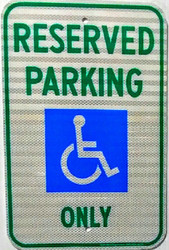Handicapped Parking - History and Current Issues
Posted by April L. on 27th Jul 2017
Background
The Civil Rights Movement as a turning point in American history isn't just about race relations, but of the rights of all citizens. The 1960s saw the passing of crucial civil rights laws that protected minorities and women–the Civil Rights Act (1964), the Voting Rights Act (1965) and another Civil Rights Act (1968).
The 1964 Civil Rights Act prohibited discrimination against minorities and women. It did not protect citizens suffering from disabilities. Similarly, the Civil Rights Act of 1968 (also known as the Fair Housing Act) did not address people with disabilities. The Voting Rights Act gave minorities the right to vote in elections.
It was only in 1973, with Section 504 of the Rehabilitation Act, that the first prohibition against discrimination on the basis of disability was recognized. However, it was narrow, only applicable to recipients of financial assistance. In 1988, amendments were made to the Fair Housing Act to protect people with disabilities.
Notably, also in 1988, the first iteration of the Americans with Disabilities Act (the "ADA"), the result of recommendations in a report from the National Council on Disability, was introduced in Congress. Amendments were made and a second iteration was introduced in 1989. The Senate version passed in the Fall of 1989 but the House of Representatives version passed the next spring.
The ADA was signed into law by then President George Bush in July, 1990. It's hard to believe that it has been less than 30 years since the federal law prohibited discrimination by employers and publicly funded programs against people with disabilities.
Learn more about the ADA.
Handicapped Parking
In 1968, the Architectural Barriers Act had addressed accessibility, but only in relation to government buildings, properties, and facilities. That year, the universal symbol for accessibility and people with disabilities made its debut . In 1990, Section 4.6 of the ADA– Parking and Passenger Loading Zones– created designated parking spaces for handicapped drivers in the parking lots of businesses. These spaces needed to be closest to the business, wider than regular spaces, and on flat ground.
We should note, however, that individual states have addressed the need for reserved parking spaces as early as 1955, when Delaware provided for handicapped parking in its Code 2134.
Current Issues
Abuse of the handicapped parking space is of course, a prevalent issue. We've all seen people who sneak into the spaces because the lot is full and gamble on not getting caught. We've also heard of people who forge the handicapped parking permits so they can park closer to stores.
The problem that is cropping up, however, is when someone suffers from an invisible disability. They may be looked down upon because they don't appear disabled but have a permit and park in a handicapped parking space. More and more people are coming forward with their experiences in this regard.
Sadly, this even happens with the friendly folk north of the border. In March, 2016, one woman suffering from Osteogenesis Imperfecta ("brittle bone" disease), had a sticker plastered to her windshield that read, "Stupidity is not a disability."
Be a Good Neighbor
We at Dornbos Sign and Safety are proud of the growing recognition that all places should be accessible to those with disabilities. We are disappointed that there are a few bad apples out there who selfishly abuse things like handicapped parking spaces, especially since they make life more difficult for people who genuinely suffer from disabilities. We would like to remind everyone, however, that not all disabilities are visible, even though they can be as devastating as visible disabilities. Let's make sure we don't prejudge.
To make your handicapped parking spaces more visible, check out our selection of parking signs. Get a quote from us, or contact us if you have any questions.




